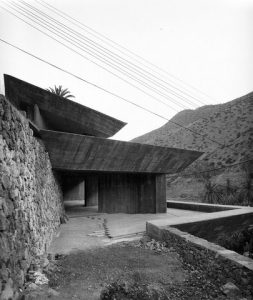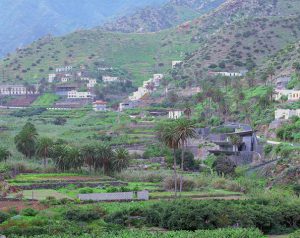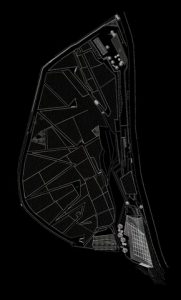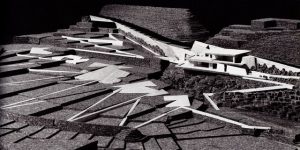Jardín Botánico del Descubrimiento de America
Datos técnicos:
Arquitectos: Fernando Menis, Felipe Artengo Rufino, José Maria Rodriguez Pastrana.
Emplazamiento: Vallehermoso. La Gomera. España.
Programa: Jardín Botánico, Centro de Visitantes.
Estructura: Hormigón armado.
Materiales: Piedra local, hormigón armado.
Estado: Construido (1999-2002).
Promotor: Excmo. Cabildo Insular de La Gomera
Descripción: El Jardín Botánico del Descubrimiento de Vallehermoso, es un parque de 16.219 m² de extensión que se encuentra en el municipio de Vallehermoso en la isla de La Gomera, Islas Canarias, España. Está ubicado entre el casco urbano y el Parque Marítimo, en las inmediaciones del barranco de Vallehermoso, en un entorno rural cuyas vistas están constituidas por tierras cultivadas y abancaladas, así como palmeras y sabinas diseminadas naturalmente en este valle.
El diseño de este parque proviene de encargo del Cabildo de la Gomera a principios de los años 90 del siglo XX. El Jardín Botánico se denomina del Descubrimiento, como homenaje a la intensa relación histórica de la isla con el Descubrimiento de América. Pretende reflejar, mediante la exposición de la flora autóctona y especies vegetales que protagonizaron el intercambio América-Europa, la relevancia que tuvieron las Islas Canarias en la ruta de las Américas. El paso de Cristóbal Colón por Canarias inauguró Una época dorada del Archipiélago como punto de escala de las travesías americanas. La corriente que, desde las inmediaciones de la cercana isla de El Hierro, une las costas de África y América, conocida como la Corriente del Atlántico Norte, se convirtió en la gran autopista que forjó el imperio español.
El jardín botánico del Descubrimiento alberga especies vegetales de los cinco continentes, haciendo hincapié en las especies vegetales que encontraron los descubridores del Nuevo Mundo. Cuando se descubre América también se descubre el Pacífico y se intensifica el intercambio de flora de manera global. Quizás podemos datar ahí el comienzo de la globalización. Cuando los primeros europeos llegaron al Nuevo Mundo, los campesinos que allí vivían cultivaban más de un centenar de tipos de plantas comestibles desconocidas entonces en Europa: patatas, girasoles, calabacines, berenjenas, aguacates, diferentes tipos de judías y calabazas, batatas, cacahuetes, anacardos, piñas, papaya, guayaba, ñames, mandioca, zapallos, vainilla, chile, café, chocolate, entre otras. Su importancia fue tal que se estima que el 60% de todas las cosechas actuales se originaron en las Américas. Además dispone de un invernadero, un umbráculo que alberga fundamentalmente orquídeas, y que el arquitecto llamó Orquidiario, entre otras especies exóticas venidas del Nuevo Mundo.
También nos encontramos en el Jardín Botánico del Descubrimiento plantas representativas de todo el archipiélago canario, con especial cuidado de las plantas endémicas de La Gomera El uso de multitud de plantas endémicas de La Gomera permite que, al hallarse inmerso entre especies vegetales procedentes del Nuevo Mundo, el paseante pueda apreciar el valor de la flora autóctona y su importante papel en el intercambio América-Europa. Por ello, preservar el patrimonio vegetal preexistente fue primordial, y los caminos peatonales, que generan diferentes terrazas, fueron trazados de manera que respetaran las palmeras centenarias del lugar.
Las actuales amplias superficies ajardinadas fueron cuidadosamente delimitadas por itinerarios paisajísticos para albergar diferentes ejemplares de pinos canarios, dragos, helechos y brezos y que se recorren a la manera procesional. Entre ellos, pinos canarios, dragos, helechos, brezos y algunos especímenes del bosque de Laurisilva pueblan el Jardín, transportándonos al tiempo en que este bosque cubría las islas y la vida se sucedía entre esos silenciosos testigos vegetales que hace millones de años cubrían gran parte de los trópicos de la Tierra, conservándose en la Gomera este ecosistema vegetal exuberante caracterizado por una elevada humedad, sin cambios estacionales y con una gran diversidad de especies botánicas.
Fernando Menis, quien fue el director de las obras, contó con la colaboración del botánico David Bramwell, convirtiendo la experiencia del Jardín del Descubrimiento en un recorrido natural, cultural e histórico además de sensorial, contribuyendo a la labor didáctica e investigadora que este lugar desempeña. Con el tiempo las trazas rectilíneas del proyecto, diseñadas buscando semejanzas con el espacio natural, libre y abierto del proyecto que se superponen y permiten diferentes itinerarios paisajísticos se han ido fundiendo con la naturaleza y el trazado geométrico inicial se ha ido volviendo sinuoso con el crecimiento de la vegetación creando efectos sorpresa dentro de un paisaje idílico.
Los caminos peatonales, en rampa, pensados para conseguir pendientes suaves, que permitan el paseo relajado para todas las edades y personas, incluso para aquellas que puedan tener algún tipo de discapacidad, zigzaguean en el paisaje, jugando con las superficies ajardinadas, con la topografía y con elementos de la naturaleza como el agua, la vegetación, las pequeñas colinas y los minúsculos prados, buscando sorprender al observador e introducirle en diversas experiencias sensitivas. Así el visitante va adentrándose en un estado de ensueño natural que le traslada al edén que era la isla en la época del Descubrimiento de América y del Renacimiento.
El cliente perseguía también que el parque actuara como un atractor económico y potenciara las visitas de locales y foráneos al municipio de Vallehermoso, el más extenso de La Gomera, con importantes descensos de población y escaso turismo comparado con otras partes del Archipiélago Canario. Con este objetivo se creó el edificio que alberga el Centro de Visitantes y una cafetería, una edificación de dos plantas, realizada con hormigón negro, a modo de mirador, una zona que emerge suavemente en el paisaje natural del valle y actúa como límite físico y rotundo del parque con la trama urbana, y la carretera de la playa, con formas orgánicas que recuerdan a poderosos bancales que se convierten en balcones abiertos hacia el parque y hacia el fondo del barranco hasta el mar, que se divisa a lo lejos.






